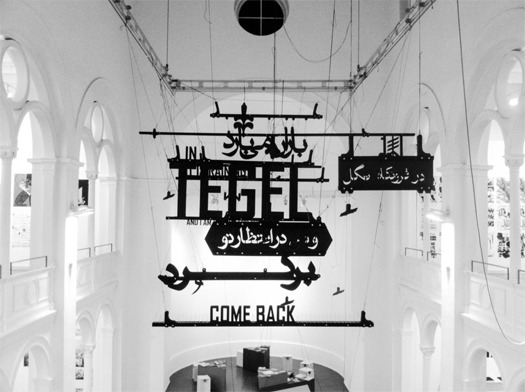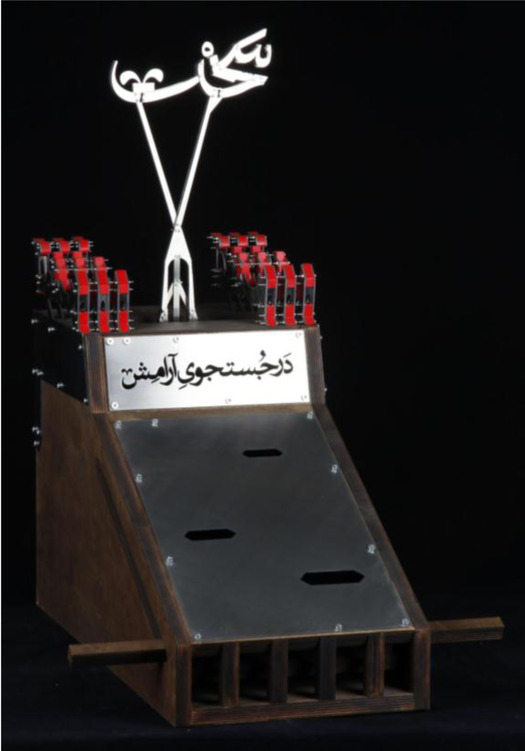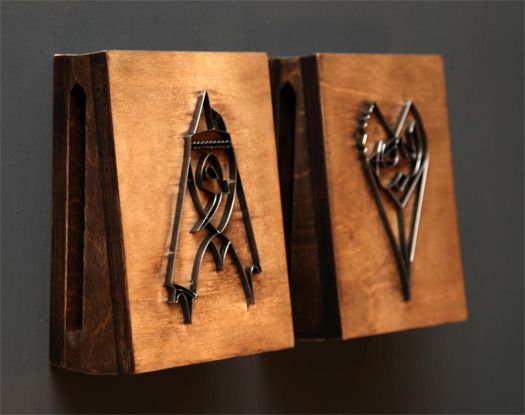
Farhad Fozouni, Tehran [0002] Poetry, Tegel, Installation, 2012, Left to Right Exhibition, Berlin
Farhad Fozouni is a leading figure in the contemporary Iranian graphic design with an international reputation and impressive list of accomplishments and recognitions. (1) Fozouni dares himself to get out of his comfort zone for the sake of creating new aesthetic experiences and meanings for himself as well as his viewer by creating unique poems. His tactile poetry not only reveals his continuous experimentation and discovery of new forms of artistic expression but also displays his desire to fully engage his viewers by getting them to touch and feel his words/images. The central role of poetry in Fozouni’s life is similar to that described by the renowned Iranian poet Forough Farrokhzad: “Poetry is a tool for me to relate to the world, relate to existence in a broader sense. When you compose poetry, you can say: I exist or I existed otherwise how can you say I exist or I existed? I don’t search for anything in my poetry, I actually find myself in my poetry.”

Left: Farhad Fozouni, Tehran [0003] Poetry, Cafe Kotti, 2012 Right: Farhad Fozouni, Eye drops poetry, 2010
Fozouni has created eighteen poems(2) since 2008, and in each he has experimented with various mediums such as pen drawing, digital print, silkscreen, wood, metal and plexiglass. Every poem reveals his love for word and image and demonstrates his superb design sensitivity. Fozouni’s graphic design works and specifically his posters share the same visual language with his poems. In majority of his posters the two dimensional boxed-in-type is sitting atop a photographic image which is similar to his tactile poetry works that consist of highly structured typography arranged in the environment. The treatment of type in Fozouni’s two dimensional and three dimensional works not only have deep roots in layouts of Iranian calligraphic pieces, lithographed and hand illuminated books but also are inspired by traditional architecture. He explains (2013)3:
I decided to change all the definition that I had set up for myself in my art. I liked to work with my own text, what I wrote myself, not other people’s words that they wanted me to use in my designs for their exhibitions or promoting their cultural events. I returned to poetry which was a natural language for me since childhood and decided to use any means and medium to create my poetry. I wanted to see what happens if a poem is created in different forms and materials. I tried to stand right at the boundaries of everything to the point that it would not be easy to categorize my work as literature, graphic design or sculpture...I tried to bring in other elements into my poems such as lighting, sound, motion, and materiality ... I don’t plan before I start creating my work. I compose as the work progresses.

Left: Farhad Fozouni, Poster, Colorful Day, 2010, Offset, 100x70 cm. Right: Farhad Fozouni, Poster, Moshajjar, 2007, Offset, 100x70 cm.
In Tehran [0002] Poetry, Tegel (2012), Tight Poetry (2011) and Blades Poetry (2009-2010), Fozouni explores tangibility of type and expand his experiments that he had started in Eye drops Poetry (2010), Kitchen Poetry (2009), and Aftershock Poetry (2009). The lines, diagrams and boxed-in-type become three dimensional constructions and occupy spaces of their own.
Tehran [0002] Poetry, Tegel (4) was an installation/ poem at Right to Left Exhibition (5) which Fozouni composed during his stay in Berlin. It is his message to his beloved city, Tehran which reads: “It is raining in Tegel Airport and I am waiting for you, come back.” Fozouni is deeply in love with Tehran, has named his design firm Studio Tehran and been in continuous conversation with the city which has been a source of inspiration for his art and identity. In this poem Fozouni continues his multilayered and multimedia conversation with the city. Fozouni explains:
In general this airport is a strange place which is filled with energy from arrivals and departures, hopes, sorrows and stories. It is a very peculiar, vast and frightening environment. Usually the space that is designated for the flight information is empty and situated high up therefore I created the Tegel poem with black and white letters which were suspended in the air. When you stand beneath these gigantic writings and look above, you can feel the anticipation more. The installation/poem has a solid structure but the arrangement is fragmented and weak. The many strings that are holding the type are chaotic and insecure. In the section that I am begging Tehran to return to me there are spikes that prevents birds from sitting on it and keep it sacred. This reveals my hopelessness and knowledge that this structure/poem should stay here and I am planning for it stability. It is also shows a sort of poetic playfulness which you are standing in one city’s airport and ask another city to return to you as if you left and she wanted you to leave but you want her to ask you to return. In this poem not words but the architecture is creating the poem.
Tehran has become Fozouni’s obsession and as a designer he has been trying to understand the city and search for a unique visual language and style for it. “I tried to copy my design layout from the city. I thought if Swiss design is about order and structure, Tehran design should also reflect its essence. It should consist of many rules that I create and don’t obey and many unclear rules that I follow without any reason. It is a harsh yet lovely place.” During this process, Fozouni’s relationship with Tehran and exploring her character is an ongoing journey of artistic self-discovery as well as a unique approach for inventing a new Iranian design language with an accent specific to Tehran.

Farhad Fozouni, Tight Poetry, 2011, Steel, wood and plexiglass
In his other poem, Tight Poetry Fozouni allows his reader/viewer touch his words and invites them to experience his most intimate feelings like loneliness, fear and searching for inner peace. The poem consists of one line which is “I tightly re-view your embrace in search of tranquility” and is made of steel, wood and plexiglass and engages the viewer by allowing them to touch its words and search and discover the missing parts that are concealed in its physical structure. For example the viewers have to find the ending phrase (I re-view) that is hidden in one of the three sockets of the poem/machine and in this tactile search for the poem’s components they have to embrace the apparatus and experience the “re-viewing” process. Yet the formidability of the machine as an object does not allow the viewers to experience the desired tranquility and in fact transmits Fozouni’s need for peace and his inability to find it to the viewer.

Farhad Fozouni, Blades Poetry, 2009-2010, Wood and metal, 21x15x9 cm.
In the Blades Poetry series Fozouni has combined type and familiar images to create unknown icons made of sharp blades stuck in wooden backgrounds. The unfamiliar forms of the blades and boards bring to mind the familiar images of kitchen knives and cutting boards. Fozouni explains: “These are imaginary entities made of known objects. It is like a nightmare which is made of a combination of all the familiar things that transform to something disturbing similar to terrifying invented creatures that are half insect half animal... The blades invite you to touch them yet make you scared like touching carnivorous flowers.” Typographical elements of the Blades Poetry series consist of images of phonetic marks where letters and words are omitted and only sounds remain. In each piece the viewer can only read the sound of a letter like “O” and gets involved with the process of reading but in fact not reading anything. Fozouni compares this to a scream which still communicates its message without using any words.
Tactile poetry of Farhad Fozouni is an exclusive artistic process of exploring materials, finding connections and coming up with innovative ideas for him and an inclusive experience of finding new aesthetic meanings by being part of his artwork for his viewers.
1 Farhad Fozouni not only runs his successful design firm, Studio Tehran (www.studiotehran.com) where he has created posters, layouts for books and magazines, film titles, and music videos but also teaches and conducts workshops on graphic design. Fozouni has been actively involved in research and writing about Iranian typography and morphology of Persian script and is an editorial member of Dabireh which is an Iranian journal of critical writings and professional commentary on typography. The founder and chief editor of Dabireh is Reza Abedini.
2 In Praise Poetry (2008), Lips Poetry (2008), Blue screen poetry (2008- 2010), Aftershock Poetry (2009), Kitchen poetry (2009), Military Service Poetry (2009), Blades poetry (2009-2010), Eye drops poetry (2010), Hero Poetry (2010), Tehran-Kenar Poetry (2008-2010), Tight Poetry (2011), Nightmare Poetry (2011), Slideshow Poetry (2011), Tehran [0000] Poetry, Tehran Map (2010), Tehran [0001] Poetry Vakhan Music (2011), Tehran [0002] Poetry, Tegel (2012), Tehran [0003] Poetry, Cafe Kotti (2012), and Berlin [0004] Poetry (2013).
3 All of Farhad Fozouni’s quotations in this essay are from his interview with Roshanak Keyghobadi (April, 2013).
4 Tehran [0002] Poetry, Tegel was part of Fozouni’s Tehran Poetry series that he has been creating since 2010. The poems are: Tehran [0000] Poetry, Tehran Map (2010), Tehran [0001] Poetry, Vakhan Music (2011), Tehran [0002] Poetry, Tegel (2012), and Tehran [0003] Poetry, Cafe Kotti (2012).
5 Right-to-Left was an exhibition in Berlin held in 2012 which featured 15 artists and graphic designers, and presented experimental typography, street art and graffiti by artists from Iran and the Arab world.
2 In Praise Poetry (2008), Lips Poetry (2008), Blue screen poetry (2008- 2010), Aftershock Poetry (2009), Kitchen poetry (2009), Military Service Poetry (2009), Blades poetry (2009-2010), Eye drops poetry (2010), Hero Poetry (2010), Tehran-Kenar Poetry (2008-2010), Tight Poetry (2011), Nightmare Poetry (2011), Slideshow Poetry (2011), Tehran [0000] Poetry, Tehran Map (2010), Tehran [0001] Poetry Vakhan Music (2011), Tehran [0002] Poetry, Tegel (2012), Tehran [0003] Poetry, Cafe Kotti (2012), and Berlin [0004] Poetry (2013).
3 All of Farhad Fozouni’s quotations in this essay are from his interview with Roshanak Keyghobadi (April, 2013).
4 Tehran [0002] Poetry, Tegel was part of Fozouni’s Tehran Poetry series that he has been creating since 2010. The poems are: Tehran [0000] Poetry, Tehran Map (2010), Tehran [0001] Poetry, Vakhan Music (2011), Tehran [0002] Poetry, Tegel (2012), and Tehran [0003] Poetry, Cafe Kotti (2012).
5 Right-to-Left was an exhibition in Berlin held in 2012 which featured 15 artists and graphic designers, and presented experimental typography, street art and graffiti by artists from Iran and the Arab world.
